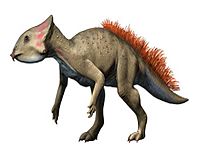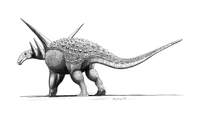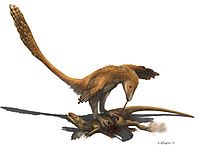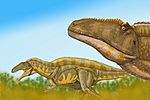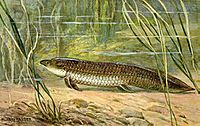Cloverly Formation facts for kids
Quick facts for kids Cloverly FormationStratigraphic range: Aptian-Albian |
|
|---|---|
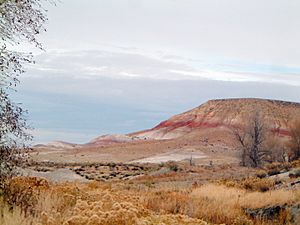
Brightly colored strata of the Himes Member of the Cloverly Formation near Shell, Wyoming
|
|
| Type | Geological formation |
| Sub-units | Pryor Conglomerate, Little Sheep Member, Himes Member |
| Underlies | Thermopolis Shale |
| Overlies | Morrison Formation |
| Thickness | 150–400 ft (46–122 m) |
| Lithology | |
| Primary | Mudstone |
| Other | Conglomerate, sandstone |
| Location | |
| Region | |
| Country | |
| Type section | |
| Named for | Cloverly post office, Wyoming |
| Named by | Nelson Horatio Darton, 1904 |
The Cloverly Formation is a geological formation of Early Cretaceous age (Aptian to Albian stage) that is present in parts of Montana, Wyoming, Colorado and Utah in the western United States. It was named for a post office on the eastern side of the Bighorn Basin in Wyoming by N.H. Darton in 1904. The sedimentary rocks of formation were deposited in floodplain environments and contain vertebrate fossils, including a diverse assemblage of dinosaur remains. In 1973, the Cloverly Formation Site was designated as a National Natural Landmark by the National Park Service.
Contents
Stratigraphy
The Cloverly Formation rests disconformably on the Morrison Formation and is conformably overlain by the Thermopolis Shale. It is subdivided into a variety of members, depending on the location. In the Bighorn Basin along the Montana-Wyoming border, Moberly (1960) divided the Cloverly into the following three members:
- The Pryor Conglomerate lies at the base and contains abundant black chert. It is named from thick beds exposed on the west side of the Pryor Mountains.
- The Little Sheep Member lies in the middle and is composed of pale-purple, gray to almost white, bentonitic mudstone.
- The uppermost unit is the Himes Member, which contains some coarse-grained channel sandstone deposits, but consists primarily of brightly multicolored (variegated) mudstones.
In contrast, Ostrom (1970) divided the formation into four units, which he named Units IV-VII:
- Unit IV equates to the Pryor Conglomerate of Moberly and consists of a conglomerate or conglomeratic sandstone.
- Unit V, overlaying Unit IV, consists of a lower grey-to-purple claystone with abundant fist-sized chalcedony and barite concretions; the unit is highly bentonitic and contains occasional channel sands.
- Unit VI is a discontinuous "salt and pepper" cross-stratified channel sandstone with occasional conglomerate, considered by Moberly to be part of the Himes Member.
- Unit VII, the uppermost, is a maroon to orange claystone with occasional highly rounded and polished pebbles of silica.
Age
Radiometric dating by the fission track method has yielded dates of 115 ± 10 Ma (million years ago) for the lower part of the Little Sheep Member and 108.5 ± 0.2 Ma near the top of that member, confirming that the Cloverly Formation is of Aptian to Albian age.
Depositional environment
The sediments of the Cloverly Formation were deposited in alluvial and floodplain environments. The basal conglomerates probably represent braided river deposits, while the sandstones were deposited in fluvial channels. The mudstones that contain most of the fossils represent overbank, lacustrine, and pedogenic deposits.
Vertebrate fauna
Animals recovered include the dinosaurs Deinonychus, Microvenator, Tenontosaurus, Zephyrosaurus and Sauropelta as well as fragmentary remains of Titanosaurs and Ornithomimids. As well, two genera of turtle Naomichelys and Glyptops and the lungfish Ceratodus.
Dinosaur eggs have been found in Montana.
References for data: Ostrom 1970; Cifelli et al. 1998; Cifelli 1999; Nydam and Cifelli 2002. Possible goniopholidid remains are known from the formation.
Ornithischians
| Ornithischians reported from the Cloverly Formation | ||||||
|---|---|---|---|---|---|---|
| Genus | Species | State | Stratigraphic position | Material | Notes | Images |
|
A. americanus |
|
Cloverly VII |
A basal neoceratopsian. |
|||
|
S. edwardsorum |
|
Known from "several articulated skeletons" and its armor plates are common fossils. Only one partial skull is known."." |
Articulated skeletons are often encased in carbonate caliche deposits that require acid to be removed safely. |
|||
|
T. tilleti |
|
Its remains are the most common of any dinosaur of the formation. |
Juvenile remains are sometimes found together, suggesting that young Tenontosaurus lived in sibling groups. Deinonychus teeth are sometimes associated with Tenontosaurus remains suggesting a predator–prey relationship between the two. |
|||
|
Z. schaffi |
|
Its remains are "very rare." |
||||
Saurischians
Theropod eggshell fragments are known from the formation. Unidentifiable ornithomimid remains are present and most commonly represented by toe bones. Indeterminate allosauroid remains are known from the formation. Remains identified by John Ostrom as Ornithomimus are suspected by Jack Horner to be of a new ornithomimid genus.
Color key
|
Notes Uncertain or tentative taxa are in small text; |
| Saurischians reported from the Cloverly Formation | ||||||
|---|---|---|---|---|---|---|
| Genus | Species | State | Stratigraphic position | Material | Notes | Images |
| Acrocanthosaurus | A. atokensis |
|
Cloverly VII | |||
|
D. antirrhopus |
|
Its remains are "very rare." |
Tenontosaurus remains have been recovered in association with Deinonychus teeth on several occasions suggesting a predator–prey relationship between the two. |
|||
|
M. celer |
|
Its remains are "extremely rare." Known only from a "[p]artial skeleton with partial skull." The specimen lacks feet and is catalogued as AMNH 3041. |
The type specimen AMNH 3041 was recovered by Barnum Brown from Cloverly strata in Montana in 1933. |
|||
|
O. velox |
|
Later found to be indeterminate ornithomimid remains. |
||||
|
Rugocaudia |
R. cooneyi |
|
||||
| Sauroposeidon | S. proteles |
|
Cloverly VII | |||
Mammals
| Mammals reported from the Cloverly Formation | ||||||
|---|---|---|---|---|---|---|
| Genus | Species | State | Stratigraphic position | Material | Notes | Images |
|
Corviconodon |
C. montanensis |
|||||
|
Gobiconodon |
G. ostromi |
|||||
|
Montanalestes |
M. keeblerorum |
|||||
Turtles
| Turtles reported from the Cloverly Formation | ||||||
|---|---|---|---|---|---|---|
| Genus | Species | State | Stratigraphic position | Material | Notes | |
|
Glyptops |
G. pervicax |
|||||
|
Naomichelys |
N. speciosa |
|||||
Bony fish
Indeterminate amiiformes are known from the formation.
| Osteichthyes reported from the Cloverly Formation | ||||||
|---|---|---|---|---|---|---|
| Genus | Species | State | Stratigraphic position | Material | Notes | Images |
|
Ceratodus |
C. frazieri |
|||||
|
C. nirumbee |
||||||
See also
 In Spanish: Formación Cloverly para niños
In Spanish: Formación Cloverly para niños


